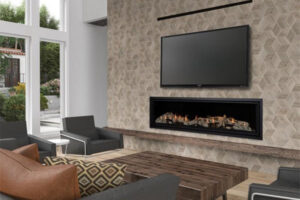The Efficiency of Gas Fireplaces
 Gas fireplaces are vital to the comfort we enjoy in our homes. However, we should not sacrifice this comfort if it exceeds the energy and funds we must use to maintain it. Therefore, you should understand how to distinguish efficient gas fireplaces from inefficient heating systems. Here is a brief overview of how gas fireplaces can be efficient.
Gas fireplaces are vital to the comfort we enjoy in our homes. However, we should not sacrifice this comfort if it exceeds the energy and funds we must use to maintain it. Therefore, you should understand how to distinguish efficient gas fireplaces from inefficient heating systems. Here is a brief overview of how gas fireplaces can be efficient.
Heat Efficiency
Heat efficiency refers to the percentage of fuel converted into heat instead of wasted. The higher the heat efficiency, the more efficient the device. The two measurements used to determine the heat efficiency of a gas fireplace are the Annual Fuel Utilization Efficiency (AFUE) and the British Thermal Unit (BTU).
Annual Fuel Utilization Efficiency
The AFUE measures how much of the fire burned by the fireplace creates valuable heat. The AFUE of a gas furnace is the percentage of heat produced by the furnace compared to the amount of fuel consumed. Gas fireplaces have a heat efficiency of around 65 to 85%. Thus, 65 to 85% of the fuel consumed by the fireplace generates helpful heat, while the rest becomes waste.
British Thermal Unit
BTU stands for British Thermal Unit and measures the heat required to raise the temperature of one pound of water by one degree Fahrenheit. The BTU rating of a gas fireplace indicates the maximum amount of heat that the fireplace can generate in terms of how much gas is consumed.
The lower the BTU rating, the less fuel the fireplace uses, and therefore the more efficient it is. Most efficient gas fireplaces have BTU ratings between 10,000 and 70,000 per hour.
Energy Efficiency
Energy efficiency is the use of minimum energy to provide similar results. In general, products and services with higher energy efficiency use less energy to provide the same level of service.
Gas fireplaces are energy efficient because they use less energy to provide the same level of service as traditional fireplaces. Gas fireplaces are more efficient because they do not require the same amount of ventilation as traditional models like wood stoves or fireplaces.
Fireplaces that need a lot of air to keep the fire burning will let a lot of heat escape from the chimney. On the other hand, gas fireplaces are self-contained. Thus, less heat escapes, and more of the heat produced by the fireplace stays in your home.
Another reason gas fireplaces are more efficient is that they provide a more consistent source of heat. You can control how your fireplace uses gas with an automated thermostat that adjusts the intensity or a manual control where you increase or decrease the heat intensity. Also, you do not have to worry about energy wastage when the fireplace is not in use because you can activate and deactivate it easily.
Cost Efficiency
Cost efficiency is a measure of how efficiently a system uses resources. Fuel is one of the most important things to consider in cost efficiency. Natural gas and propane, standard fuels in gas fireplaces, are much cheaper than electricity. Therefore, you can use a gas fireplace more frequently with minimal fuel costs.
The second consideration is the efficiency of the fireplace itself. While previous-generation gas fireplaces suffered from massive heat loss, modern designs are more efficient than others as they use less fuel and produce fewer emissions. Therefore, gas fireplaces will consume less gas for similar performance, which can offset your gas utility bills.


